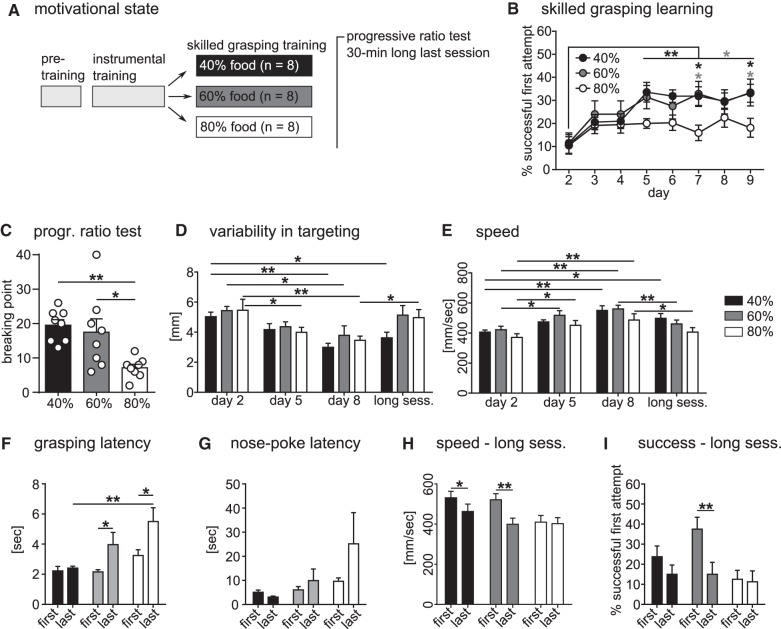Figure 2.
Effects of motivational state as induced by food restriction on skilled instrumental grasping. (A) Experimental design. For skilled grasping training, animals were split into three groups receiving either 40%, 60%, or 80% of ad libitum food levels. (B) Success score as shown by percentage success on first attempt in skilled grasping over training time (time: F(7,147) = 8.79, P < 0.0001; group: F(2,21) = 2.94, P = 0.07). The 40% and 60% food level groups showed a significant increase in performance over time between day 2 and days 5–9 (40%: max. P < 0.01, 60%: max. P < 0.05) and performed significantly better than the 80% group at the end of training (day 7 and 9, P < 0.05). (C) Number of nose-pokes required to open the door to the sugar pellet was successively increased in the progressive ratio test which showed strong differences in breaking points between groups (F(2,21) = 7.00, P = 0.005). The 80% group had a significantly lower breaking point than the 40% (P < 0.01) and 60% (P < 0.05) groups. (D) Variability of paw trajectories in targeting the pellet was strongly reduced with training (time: F(3,63) = 15.09, P < 0.0001) in all groups from days 2 to 8 (40%: P < 0.01, 60%: P < 0.05, 80%: P < 0.01) and in the 80% group from days 2 to 5 (P < 0.05). In the long last session, the 80% groups showed an increased variability compared with day 8 (P < 0.05), while the 40% still showed a reduced variability compared with the beginning of training (day 2) (P < 0.05). (E) Average speed of paw trajectories showed a strong increase with training (time: F(3,63) = 21.55, P < 0.0001), which was strongest between days 2 and 8 for all groups (P < 0.01), but also significant between days 2 and 5 (60%: P < 0.05, 80%: P < 0.05). In the long last session, the 60% (P < 0.01) and the 80% (P < 0.05) groups showed significantly slower grasps than on day 8, while the 40% group still grasped faster than at the beginning of training (day 2) (P < 0.05). (F) Latency to complete a grasping attempt after a nose-poke response has triggered door opening for the first 10 and last 10 trials in the long last session. Grasping latencies were significantly different between groups and from beginning to end of the session (group: F(2,21) = 6.10, P = 0.008; time: F(1,21) = 12.67, P = 0.002). For the 60% and 80% groups, the grasping latency significantly increased from the first 10 to the last 10 trials of the session (P < 0.05), while the 40% group showed no increase and had smaller latencies for the last 10 grasps than the 80% group (P < 0.01). (G) Latency to initiate a new trial with a nose-poke response for the first 10 and last 10 trials in the long last session was not different between groups. (H) Grasping speed was reduced over time within the long last session (time: F(1,21) = 21.71, P = 0.0001). Both the 40% (P < 0.05) and the 60% groups (P < 0.01) reduced their movement speed over the course of the session. (I) Success rate of pellet retrieval changed significantly over time in the long last session (time: F(1,21) = 9.98, P = 0.005), with the 60% group showing a strong decrease in success from the first to the last 10 trials (P < 0.01). All data are shown as means ± SEM, n = 8 animals for all groups.

